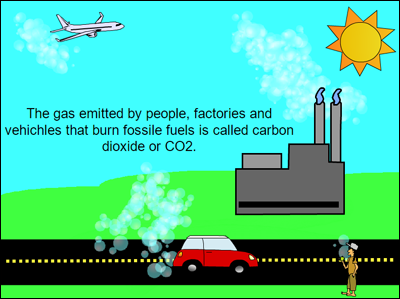
Students will write persuasively on a conservation issue and create a public service announcement to promote their cause.

Earth needs your help! While pollution has decreased in many places, we are still releasing tons of toxins into the air and water every day. Access to clean drinking water is decreasing, and landfills are filling up quickly. One and one-half acres of rainforest are lost every second.
Balancing the demands of a growing population, a high standard of living, and a healthy environment is a delicate and difficult process. Using their incredible powers of persuasion, and the techniques of persuasive writing, have students craft a public service announcement that educates citizens on environmental issues. They should make their announcement powerful enough to persuade people to change their behavior to lessen a negative impact or increase a positive impact on the environment.
As a class, brainstorm a list of things worth conserving. You may want to focus on a threatened area, like the rainforest, or look for problems your students can solve in their own communities, like waste reduction or clean water.
Have individual students choose an issue that is important to them and formulate a thesis or debatable statement about the issue. Have them research information about the issue and then review and organize their materials. Since facts are a great way to support a compelling argument, students may want to organize their facts using a fact vs. opinion graphic organizer. Students also need to determine which research information supports their argument and which information contradicts it. Once they have identified arguments against their thesis, have them develop counter arguments they can incorporate into their essays.
Students should now write a first draft of the essay, trying to get all their ideas down in logical order. When the first draft is finished, have them print and edit their work, making changes to improve the essay. This would be a great time to have students review one another’s work.
Share examples of public service announcements you find on television or online.
Most public service announcements are between 10 and 60 seconds long. Ask students how much of their essay they can they read in ten seconds. How are they going to need to think differently to make their argument in a PSA? Work as a class to brainstorm nonverbal strategies for making a compelling PSA.
Let students know they will be working on a team with other students exploring their issue to create a 30–second public service announcement. Group the students together and have them begin their work by reading their arguments to the rest of their team members.
Working as a team, ask students to identify the best arguments in each essay and brainstorm how they could share those ideas in a short PSA. Have them list the stories, facts, and ideas they think will be helpful in making an argument in their public service announcement.
Have each team complete a vision for their project to define their argument, identify their audience, refine their goal, and choose an idea to pursue. Each team should then refine their vision and begin developing a storyboard to serve as the map for the PSA design.

Teams should begin by gathering the media resources needed for their PSA. Teams may choose to work on each stage of the development process together or assign roles, such as researcher, editor, graphic artist, and director, to divide up the tasks. Have students use the tools in Wixie to develop their PSA.
Have teams share their PSAs with the class while talking about the collaborative process it took to create the PSA. You might choose to share the PSAs on your school web site, or present them during morning announcements. You may also be to share the PSAs with your local access television station to help educate the community.
The fact vs. opinion organizer, vision, and storyboard will give insight to the direction teams are heading with their project. Assessing these items and observing the collaborative process before students begin creating their PSA. You may want to have students keep a project journal or write daily reflections, as it will be impossible to hear every student’s comments during the process. The final PSA will help you assess their understanding of the issue as well as their ability to persuade viewers using multimedia.
Chiras, Daniel D., John P. Reganold, and Oliver S. Owen. Natural Resource Conservation: Management for a Sustainable Future ISBN: 0130333980
Botkin, Daniel B. and Edward A. Keller. Environmental Science: Earth as a Living Planet ISBN: 0471389145
Daily, Gretchen C. Nature’s Services: Societal Dependence on Natural Ecosystems. ISBN: 1559634766
Writing Standards
Text Types and Purposes
1. Write arguments to support claims in an analysis of substantive topics or texts, using valid reasoning and relevant and sufficient evidence
2. Write informative/explanatory texts to examine and convey complex ideas and information clearly and accurately through the effective selection, organization, and analysis of content.
Production and Distribution of Writing
4. Produce clear and coherent writing in which the development, organization, and style are appropriate to task, purpose, and audience.
6. Use technology, including the Internet, to produce and publish writing and to interact and collaborate with others
Research to Build and Present Knowledge
7. Conduct short as well as more sustained research projects based on focused questions, demonstrating understanding of the subject under investigation.
9. Draw evidence from literary or informational texts to support analysis, reflection, and research.
Range of Writing
10. Write routinely over extended time frames (time for research, reflection, and revision) and shorter time frames (a single sitting or a day or two) for a range of tasks, purposes, and audiences
Speaking and Listening Standards
Presentation of Knowledge and Ideas
5. Make strategic use of digital media and visual displays of data to express information and enhance understanding of presentations.
CONTENT STANDARD F
As a result of activities in grades 5 - 8 , all students should develop understanding of:
• Personal health
• Populations, resources, and environments
• Natural hazards
• Risks and benefits
• Science and technology in society
III. People, Places, and Environments (middle grades)
k. propose, compare, and evaluate alternative uses of land and resources in communities, regions, nations, and the world.
3. Knowledge Constructor
Students critically curate a variety of resources using digital tools to construct knowledge, produce creative artifacts and make meaningful learning experiences for themselves and others. Students:
a. plan and employ effective research strategies to locate information and other resources for their intellectual or creative pursuits.
b. evaluate the accuracy, perspective, credibility and relevance of information, media, data or other resources.
c. curate information from digital resources using a variety of tools and methods to create collections of artifacts that demonstrate meaningful connections or conclusions.
6. Creative Communicator
Students communicate clearly and express themselves creatively for a variety of purposes using the platforms, tools, styles, formats and digital media appropriate to their goals. Students:
a. choose the appropriate platforms and tools for meeting the desired objectives of their creation or communication.
b. create original works or responsibly repurpose or remix digital resources into new creations.
c. communicate complex ideas clearly and effectively by creating or using a variety of digital objects such as visualizations, models or simulations.
d. publish or present content that customizes the message and medium for their intended audiences.

Follow us on Instagram for daily inspiration

Create a thought web, cluster, flowchart, or other graphic organizer for a lesson
Five ideas for creative classroom centers
Creative, digital book reviews
Fun and powerful ideas with animated characters

Wixie
Share your ideas, imagination, and understanding through writing, art, voice, and video.

Rubric Maker
Create custom rubrics for your classroom.

Pics4Learning
A curated, copyright-friendly image library that is safe and free for education.

Wriddle
Write, record, and illustrate a sentence.

Get creative classroom ideas delivered straight to your inbox once a month.
Topics